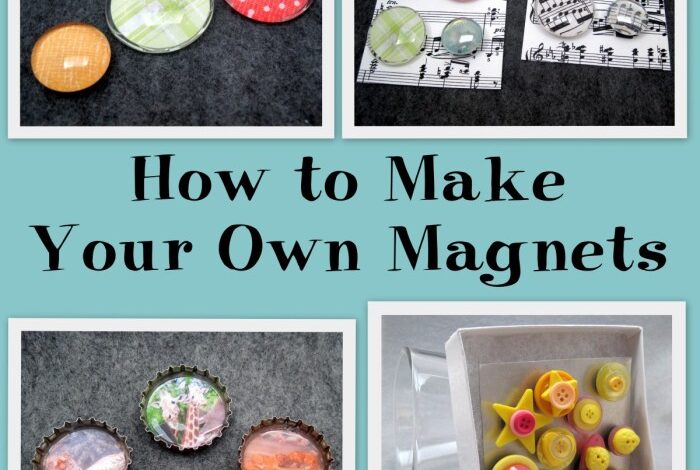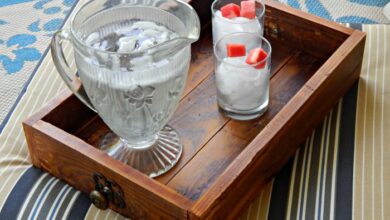
Make your own clay word magnets: a fun and creative way to personalize your space and express your unique style! These charming little magnets are perfect for adding a touch of personality to your refrigerator, whiteboard, or any magnetic surface.
From simple messages to intricate designs, the possibilities are endless!
This DIY project is not only fun but also incredibly versatile. You can create word magnets for yourself, as thoughtful gifts for friends and family, or even use them to decorate your home with a personal touch. Imagine crafting unique words that reflect your hobbies, favorite quotes, or even inside jokes.
The possibilities are truly endless!
Introduction to Clay Word Magnets: Make Your Own Clay Word Magnets

Clay word magnets are a fun and versatile craft that allows you to express your creativity and personalize your space. They are simple to make, requiring only a few basic materials, and offer endless possibilities for design and customization. Clay word magnets can be used to create unique decorations for your home, office, or refrigerator, or as thoughtful and personalized gifts for friends and family.
They can also be used for educational purposes, such as teaching children about letters and words.
Creative Possibilities and Applications
Clay word magnets can be used to create a variety of designs, from simple and elegant to bold and whimsical. You can use different colors, textures, and patterns to create unique and eye-catching pieces. Here are some examples of how clay word magnets can be used:
- Home Decor: Create a personalized message for your refrigerator, such as “Welcome Home” or “Family Rules.” You can also use them to decorate your bulletin board or create a unique wall art piece.
- Gifts: Clay word magnets make thoughtful and personalized gifts for birthdays, holidays, or just because. You can create a custom message or design that reflects the recipient’s personality or interests.
- Educational Tools: Clay word magnets can be used to teach children about letters and words. They can also be used to create spelling games or word puzzles.
Materials and Tools
Creating your own clay word magnets is a fun and rewarding craft project. You’ll need a few essential materials and tools to get started. This section will guide you through the materials needed for your project, including different clay types, essential tools, and optional embellishments.
Clay Types
The type of clay you choose will depend on your project’s desired look and feel.
- Polymer Clay:Polymer clay is a versatile option that comes in a wide range of colors and textures. It’s oven-baked, making it durable and water-resistant. It’s a great choice for intricate designs and detailed lettering.
- Air-Dry Clay:Air-dry clay is a convenient option that hardens at room temperature. It’s a good choice for beginners and quick projects. It’s typically less durable than polymer clay and can be susceptible to cracking.
- Ceramic Clay:Ceramic clay is a more traditional option that requires firing in a kiln. It’s highly durable and can be glazed for a variety of finishes. It’s a good choice for projects that need to be water-resistant or exposed to the elements.
Essential Tools
You’ll need a few basic tools to work with clay.
- Clay Rolling Pin:A clay rolling pin helps create even thickness for your clay pieces. You can use a standard rolling pin or a dedicated acrylic rolling pin designed for clay.
- Clay Sculpting Tools:A set of clay sculpting tools, such as a modeling tool, a clay knife, and a ball tool, will help you shape and detail your clay pieces.
- Clay Cutting Tools:Clay cutting tools are essential for shaping your clay and creating precise edges.
- Exacto Knife:An exacto knife is a sharp blade used for making detailed cuts and trimming edges.
- Work Surface:A non-stick work surface, such as a piece of parchment paper or a silicone mat, will prevent your clay from sticking.
- Magnet Sheets:Magnet sheets are available in various sizes and thicknesses. Choose a size that will fit your clay word pieces and a thickness appropriate for the weight of your clay.
Optional Embellishments
Adding embellishments to your clay word magnets can enhance their visual appeal.
- Acrylic Paint:Acrylic paint is a versatile and durable option for adding color and details to your clay pieces.
- Glitter:Glitter can add a touch of sparkle to your clay magnets.
- Beads:Beads can be used to add texture and dimension to your clay pieces.
- Sequins:Sequins can add a touch of glam to your clay magnets.
Preparing the Clay
Preparing your clay properly is essential for creating smooth, durable, and attractive word magnets. This involves conditioning the clay to achieve the right consistency and learning the techniques for shaping it.
Conditioning the Clay
Before you begin sculpting, your clay needs to be workable. This means ensuring it’s soft and pliable enough to mold and shape without cracking or crumbling. The conditioning process varies depending on the type of clay you’re using.
- Polymer Clay:Polymer clay typically comes in a firm, solid block. You’ll need to soften it by kneading it thoroughly with your hands. This process helps to distribute the plasticizers evenly throughout the clay, making it more flexible. You can use a rolling pin or a pasta machine to achieve a more uniform consistency.
- Air-Dry Clay:Air-dry clay is often sold in a pliable, ready-to-use form. However, if it’s become too dry or stiff, you can rehydrate it by kneading it with a little water. Be careful not to add too much water, as this can make the clay too sticky.
- Ceramic Clay:Ceramic clay requires a different approach. It’s usually sold in a damp, workable state. However, if it’s become too dry, you can add a little water and knead it to rehydrate it. If it’s too wet, you’ll need to let it air dry slightly before working with it.
Shaping the Clay
Once your clay is conditioned, you can start shaping it into your desired words. There are various techniques you can use, depending on the complexity of your design.
- Rolling:For simple words or letters with straight lines, you can roll the clay into a flat sheet using a rolling pin or pasta machine. Then, you can cut out the letters using cookie cutters or a sharp knife.
- Molding:For more intricate designs, you can use molds to shape the clay. Simply press the clay into the mold and gently remove it once it’s set. You can find molds in various shapes and sizes, including letter molds specifically designed for crafting.
- Sculpting:For truly unique designs, you can sculpt the clay by hand using tools like sculpting tools, toothpicks, or even your fingers. This allows for greater control and creativity, allowing you to create three-dimensional letters with intricate details.
Importance of Proper Clay Preparation
Proper clay preparation is crucial for achieving the desired results in your word magnet project.
Crafting clay word magnets is a fun way to personalize your fridge or magnetic board. I often find inspiration for words in my my used book collection , where I’m constantly discovering new and intriguing vocabulary. Once I’ve chosen my words, I roll out the clay, cut out the letters, and bake them until they’re hard.
Then, I simply add a magnet to the back and display them proudly.
- Smoothness:Conditioning the clay ensures it’s smooth and free of air bubbles, resulting in a polished finish for your word magnets.
- Durability:Well-conditioned clay is less prone to cracking or crumbling, making your word magnets more durable and long-lasting.
- Uniformity:Properly prepared clay ensures a consistent texture and color throughout your word magnets, leading to a more professional look.
Creating Word Shapes
Now that your clay is ready, it’s time to get creative and start shaping your words! There are several methods you can use to form letters and words, each with its own advantages and techniques. Let’s explore some popular methods and learn how to create beautiful, personalized word magnets.
Hand-Building
Hand-building is a versatile and accessible technique that allows you to sculpt letters directly with your hands. This method offers a lot of freedom for creating unique and expressive word shapes.
- Pinch Pot Technique:Start by rolling a small ball of clay and then gently press a hole into the center with your thumb. Use your fingers to slowly shape the clay into a letter form.
- Coil Building:Roll long, thin coils of clay and then arrange them into letter shapes. You can join the coils by gently pressing them together and smoothing out any gaps.
- Slab Building:Roll out a flat sheet of clay with a rolling pin and then use a knife or cookie cutters to cut out letter shapes. You can then layer these slabs to create more complex letters or words.
Tips for Hand-Building
- Keep your hands and tools moistto prevent the clay from sticking.
- Use a smooth, consistent pressurewhen shaping the clay to avoid uneven surfaces.
- Take your time and work slowly, especially when creating detailed letter forms.
- Smooth out any rough edgeswith your fingers or a damp sponge.
Baking and Finishing
The moment of truth has arrived! After creating your clay word magnets, it’s time to bake them to harden them and make them durable. Baking is a crucial step in the process, ensuring your creations last.
Baking Techniques
Baking techniques for clay vary depending on the type of clay you’re using. It’s crucial to follow the manufacturer’s instructions for the specific clay you’ve chosen. This ensures your clay bakes correctly and achieves the desired hardness.
Baking Process, Make your own clay word magnets
The baking process typically involves placing your clay creations in an oven at a specific temperature for a set amount of time.
The recommended baking temperature and duration are usually provided on the clay package.
Temperature and Duration
Generally, polymer clay is baked at temperatures ranging from 265°F to 300°F (130°C to 150°C) for 15 to 30 minutes, depending on the thickness of the clay.
Safety Precautions
- Always bake your clay in a well-ventilated area, as the baking process can release fumes.
- Use oven mitts when handling hot baking trays or removing baked clay from the oven.
- Never leave your clay unattended while baking.
Finishing Techniques
Once your clay word magnets are baked and cooled, you can finish them with various techniques to enhance their appearance and durability.
Sanding
Sanding smooths out any rough edges or imperfections on your clay word magnets. You can use fine-grit sandpaper to achieve a smooth finish.
Painting
Painting adds color and detail to your clay word magnets. Use acrylic paints, which are specifically designed for use on clay.
Crafting clay word magnets is a fun and creative way to personalize your fridge or workspace. After a satisfying session of sculpting and baking, you might feel inspired to treat yourself to a new workout outfit. Head over to Brown Thomas to find the perfect activewear for your next fitness adventure.
Once you’re feeling energized and stylish, you can return to your clay creations with renewed enthusiasm, adding a touch of personality to your surroundings.
Adding Embellishments
Embellishments can further personalize your clay word magnets. You can add glitter, sequins, beads, or other decorative elements to create unique designs.
Making your own clay word magnets is a fun and creative way to personalize your space. You can use them to decorate your fridge, bulletin board, or even your desk. And if you’re feeling really ambitious, you can even use them to create your own custom artwork.
If you’re looking for a way to add a personal touch to your Instagram photos, you can try making Instagram stickers at home. You can use these stickers to decorate your photos, add a bit of whimsy, or even create a unique brand for your social media presence.
Just like making clay word magnets, creating Instagram stickers at home allows you to express your creativity and have fun with it.
Attaching Magnets
The final step in creating your clay word magnets is attaching magnets to the back of your baked clay creations. This ensures that your magnets will stick to any metal surface, making them perfect for decorating your refrigerator, whiteboard, or any other magnetic surface.To ensure a strong and reliable magnetic adhesion, it’s essential to use the right type of magnets and adhesives.
We will discuss different methods for attaching magnets, along with tips to ensure their long-lasting bond.
Types of Magnets
The type of magnet you choose will depend on the size and weight of your clay word magnets. Here are the most common types:
- Ceramic Magnets: These are the most affordable type of magnet and are suitable for lighter-weight items. They are generally quite strong for their size.
- Neodymium Magnets: These are the strongest type of magnet available, often referred to as “rare earth magnets.” They are excellent for heavier items or when you need a powerful magnetic force.
- Flexible Magnets: These are thin and flexible, making them ideal for attaching to curved surfaces or when you need a magnet that can be easily cut to size. They are often available in sheet form.
Adhesive Options
Once you have chosen your magnets, you will need a suitable adhesive to attach them to your clay.
- Epoxy Glue: Epoxy glue is a strong and durable adhesive that is suitable for attaching magnets to clay. It creates a strong bond that can withstand the test of time.
- Hot Glue: Hot glue is a quick and easy option for attaching magnets, but it may not be as durable as epoxy glue. It is suitable for lighter-weight magnets and clay pieces.
- Super Glue: Super glue can also be used to attach magnets to clay, but it is important to use it sparingly as it can be difficult to remove if you make a mistake.
Tips for Secure Adhesion
- Clean the Surface: Before applying any adhesive, make sure the back of your clay word magnet is clean and free of any dust or debris. This will help the adhesive bond properly.
- Use the Right Amount of Adhesive: Apply a thin, even layer of adhesive to the back of the clay and the magnet. Too much adhesive can make it difficult to attach the magnet securely, while too little may result in a weak bond.
- Press Firmly: Once you have applied the adhesive, press the magnet firmly against the back of the clay and hold it in place for a few minutes to allow the adhesive to set.
- Let it Cure: Allow the adhesive to cure completely according to the manufacturer’s instructions. This will ensure a strong and lasting bond between the magnet and the clay.
- Test the Magnet: Once the adhesive has cured, test the magnet by placing it on a metal surface. It should stick firmly and be able to hold the weight of the clay word magnet without falling off.
Design Ideas and Inspiration
Let your creativity soar! This is where the real fun begins. Clay word magnets offer a blank canvas for your unique style and personality. Explore different letter styles, color schemes, and embellishments to create one-of-a-kind pieces.
Letter Styles
The style of your letters will set the tone for your word magnets. Consider these possibilities:
- Classic Serif:These timeless fonts, like Times New Roman or Garamond, add a touch of elegance and sophistication.
- Modern Sans Serif:Fonts like Arial or Helvetica offer a clean and contemporary look.
- Script:Cursive fonts, like Brush Script or Lucida Handwriting, add a personal touch and a hint of whimsy.
- Bold and Blocky:Fonts like Impact or Arial Black make a strong statement and are perfect for eye-catching designs.
Color Schemes
Color plays a vital role in creating a mood and theme.
- Monochromatic:Using different shades of a single color creates a sense of unity and harmony.
- Complementary:Colors opposite each other on the color wheel, like red and green, create high contrast and visual excitement.
- Analogous:Colors that sit next to each other on the color wheel, like blue and green, create a sense of calmness and balance.
- Triadic:Three colors equally spaced on the color wheel, like red, yellow, and blue, create a vibrant and dynamic design.
Embellishments
Adding embellishments adds depth and texture to your word magnets.
- Texture:Create interesting textures by using tools like a toothpick, a fork, or a sponge to add patterns and designs to the clay.
- Glitter:Sprinkle glitter onto wet clay for a sparkly effect.
- Beads:Add beads or small charms to the clay for a touch of whimsy.
- Paint:Paint the clay with acrylics after it has been baked for added color and detail.
Inspirational Examples
- Rustic Farmhouse:Create word magnets with a rustic farmhouse theme using natural colors like brown, beige, and cream. Use a textured clay to mimic wood and add burlap or twine accents.
- Modern Minimalist:Use clean lines and bold colors to create a modern minimalist look. Consider using black and white, or a single bold color with white accents.
- Whimsical Fairy Tale:Embrace your inner child and create word magnets with a whimsical fairy tale theme. Use bright colors, glitter, and small charms like butterflies or flowers.
Safety Precautions
Clay crafting and baking can be enjoyable, but it’s crucial to prioritize safety. Always remember that working with clay and ovens requires careful handling and awareness of potential hazards. Here are some essential safety precautions to keep in mind:
Handling Clay Safely
Clay can be messy, but with proper handling, you can avoid unwanted messes and ensure a clean work environment.
- Wear a dust mask or respirator when handling dry clay to prevent inhaling fine clay particles, which can irritate your respiratory system.
- Use a dedicated workspace for clay projects, covering surfaces with a protective layer like plastic sheeting or newspaper to prevent staining.
- Keep clay away from food preparation areas and wash your hands thoroughly with soap and water after handling clay.
Avoiding Dust Inhalation
Clay dust can be harmful to your lungs, especially when inhaled over extended periods.
- Always wear a dust mask or respirator, particularly when sanding or working with dry clay.
- Work in a well-ventilated area, using a fan or opening windows to circulate air.
- Avoid using a vacuum cleaner to clean up clay dust, as it can spread the dust into the air.
- Use a damp cloth or sponge to wipe up spills and dust, preventing the dust from becoming airborne.
Using Proper Ventilation
Baking clay in an oven releases fumes and odors.
- Ensure your oven is properly ventilated, with a working vent hood or an open window to allow fumes to escape.
- Avoid baking clay in a poorly ventilated area, as it can lead to headaches, dizziness, and respiratory irritation.
- Open windows or doors to create air circulation and prevent the buildup of fumes.
- If possible, bake clay in a separate room or outdoor area to minimize exposure to fumes.






